When it’s cold outside, we want to stay comfortable inside. To ensure comfort during the winter months, nothing is as essential as a furnace — the great workhorse of domestic heating in the United States. For the furnace to work properly, however, it must be the right size. Buying the wrong furnace size for your home is an all-too-common mistake that can lead to uncomfortable temperatures and unnecessary expenses. To avoid these headaches, follow our detailed guide on how to accurately calculate the furnace size that is most suitable for your home.
The size of a furnace is based on how much heat it can produce in an hour, as measured in BTUs, or British thermal units. A BTU is the energy required to heat a pound of water by one degree Fahrenheit. The higher the BTU rating a furnace has, the more warmth it can provide.
Please note: This blog is for informational purposes only. Please always consult with an HVAC professional when choosing the right size furnace for your home.
What’s the Right Size Furnace for My Home?
If you’re building a house, you may be wondering how many BTUs you’ll need to heat it. The first factor you should consider is your home’s square footage. Bigger homes, generally speaking, require more BTUs to heat. Keep in mind, however, that this is just a starting point. Below are the furnace BTUs required for homes of certain sizes.
- Furnace for 1,200-square-foot house: 36,000 to 72,000 BTUs
- Furnace for 1,500-square-foot house: 45,000 to 90,000 BTUs
- Furnace for 1,800-square-foot house: 54,000 to 108,000 BTUs
- Furnace for 2,100-square-foot house: 63,000 to 126,000 BTUs
- Furnace for 2,400-square-foot house: 72,000 to 144,000 BTUs
As you can see, the BTU usage recommended for each house size is not a single number but rather a broad range, so square footage alone is not particularly helpful. To get a more accurate idea of the BTUs it takes to heat your home, you’ll need to consider several other factors, which we will discuss later on in the article. First, we will explain why getting the right size furnace is so important.
Why Does Furnace Size Matter For A Home?
Buying the right size furnace for your home will ensure you’re comfortable and don’t spend more on heating than you need to. Oversized and undersized heaters, on the other hand, will both cause you a slew of problems.
If Your Furnace Is Too Big For Your Home
Some may assume an oversized furnace will ensure their home stays warm, but this is not the case. A furnace that is too big can lead to the following problems:
- You’ll feel uncomfortable. Oversized heaters tend to work in quick bursts and, when it gets cold, they’ll turn on and cause certain areas of the house to warm up too quickly and become uncomfortably hot. That will, in turn, cause the heater to shut off, resulting in some parts of the house feeling like an oven and others like a freezer.
- Less energy efficiency. Frequent turning on and shutting off makes oversized heaters inefficient.
- Short lifespan. Constant cycling on and off of the heater will cause wear to the system and premature failure.
- You will have to repair it often. Not only will your system have a shorter lifespan, you’ll likely have to repair it as well — and this can be expensive.
If Your Furnace Is Too Small For Your Home
If your furnace is too small for your home, you’ll also run into several problems, many of them the same:
- You’ll feel uncomfortable. This is especially true on the coldest days of the year, when your furnace will be unable to keep up with the low temperatures. Undersized furnaces cannot make up the difference to make your home feel comfortable.
- High energy bills. Because your furnace will be running nonstop, your monthly energy bills will be higher than they need to be.
- Short lifespan. This constant running will also cause your furnace to wear out sooner.
- Uneven heating. There will be cold or hot spots around the house.
The Right Size Furnace For Your Home
A furnace that is the appropriate size for your home will warm up your house gradually. By doing this, it will be much more energy-efficient, and your equipment will last much longer. If you’ve noticed your furnace is running practically all the time, it may very well mean your furnace is too small. And if you notice it’s starting and stopping all the time, it could indicate your furnace is too big.
With an adequately sized furnace, you shouldn’t be dealing with any cold or hot pockets. It is important to remember, though, that on exceptionally cold nights, even the right size furnace may not be able to keep you comfortable. This is nothing to worry about — it just means you may still need to bundle up occasionally.
How to Calculate the Right Size Furnace
As you know, estimating the size of your residential furnace heating system involves considering a variety of factors. Here are the first two steps you should take to estimate furnace size.
- Calculate the square footage of your home. Add up the areas of all the rooms in your home you would like to heat. Your calculations will usually include all rooms, but it is possible the ducts in your home do not connect to the basement or the attic. Here’s a guide for calculating the area of rooms of specific shapes.
- To measure the area of a rectangular room, multiply the length and width.
- To measure the area of a triangular room, multiply the length and width, then divide the product by two.
- For the area of a circular room, start by measuring the radius r, which is the distance from the edge of the room to the center. Then calculate πr2. If your calculator does not have a pi (π) function, use the number 3.14.
- For unusually shaped rooms, divide them into smaller sections and measure each one separately.
- Find out What Climate Zone Your Home Is In Climate is another factor that helps determine how many BTUs you need to heat your home. Generally speaking, the farther from the equator you’re located, the more BTUs it will take to heat a square foot of your home. However, some geographic factors such as elevation and ocean currents cause BTU requirements to vary at any given latitude. Below are the five climate zones in the United States.
- Zone 1: This zone occupies the most southern regions of the United States and includes Miami, New Orleans and Houston. It has a heating factor of 30 to 35 BTUs.
- Zone 2: This zone includes coastal California and the Southern cities of Atlanta and Little Rock. Its heating factor ranges from 35 to 40 BTUs.
- Zone 3: This zone includes Virginia and extends west to Missouri and Kansas. It has a heating factor of 40 to 45 BTUs.
- Zone 4: This zone includes Boston, New York and Chicago. Its heating factor is 45 to 50 BTUs.
- Zone 5: This is the northernmost zone in the continental United States, including the cities of Buffalo and Minneapolis. Its heating factor is 50 to 60 BTUs.
Each climate zone has a recommended heating factor, which is the suggested number of BTUs per square foot. For example, Chicago and New York are both in Zone 4, which has a heating factor of 45 to 50. If you live in either of these cities, you will need a heater that produces 45 to 50 BTUs per square foot. Los Angeles and Atlanta, on the other hand, are in Zone 2, which means you’ll need 35 to 40 BTUs per square foot.
If you live in a new home or one with good insulation, you should use the lower of these two numbers. If your home is older or your insulation is poor, go with the higher number. If you’re not certain, it is always safer to go with the higher number, but try to come as close as you can so you don’t end up buying a furnace with more capacity than necessary.
For example, let’s say you live in a well-insulated 1,900-square-foot home in Zone
- Multiply your square footage by 40, the lower number recommended for the climate zone. This calculation will give you 76,000 BTUs, which should comfortably keep your house warm in that climate.
Other Factors to Consider When Sizing a Furnace For Your Home
It is necessary to consider more than just square footage, climate and insulation, however. Here are some other things you should factor in.
- Windows: If your home has a large number of windows, heat is more likely to escape. It may require you to choose a number near the upper end of your heating factor range, especially if they’re older windows.
- Exposure to sun: The amount of sunlight that hits your home will also help determine how many BTUs you need. If you have rooms that are almost always shady, reduce the necessary capacity by 10 percent. If the house gets a lot of sun exposure, increase the capacity needed by 10 percent.
- The number of dwellers: The human body dissipates heat into the surrounding air, so if a certain room regularly hosts several people, it will require fewer BTUs to heat.
- Kitchen: For the kitchen, add 4,000 BTUs.
- The number of floors: If you live in a two-story house, you will require slightly fewer BTUs because the second floor helps insulate the house.
- Age: Newer homes tend to have better insulation and fewer areas for the heat to escape.
- Desired temperature: Most people prefer temperatures between 70 and 80 degrees Fahrenheit, although if you prefer to keep the thermostat unusually high or low, this will affect your BTU requirement.
- Ceiling height: If your ceilings are exceptionally high, your home will require more BTUs to heat comfortably.
- Ceiling fans: Ceiling fans can improve circulation in your home, which can help lower BTU usage. They do this by distributing temperatures evenly throughout the entire house.
- Ductwork: If your ductwork and furnace size don’t match up, it could cause problems. For instance, if your ductwork isn’t big enough for your furnace, this will shorten the furnace’s lifespan because the air the furnace produces won’t have enough space to travel through. That will restrict the flow of air and may cause the furnace to overheat. Make sure your furnace is appropriately sized for your ductwork.
- Color of your roof: Darker-colored roofs absorb more energy from the sun than lighter ones. Even roofs that are dirty absorb significantly more energy than new, clean white roofs, which results in noticeably different BTU usages.
- Shape of your house: A house that is long and narrow will require more BTUs to heat than a square house that has the same square footage. That is because a long, narrow house has more exterior walls and will experience more heat loss as a result.
Furnace Efficiency In Your Home
When you go furnace shopping, you’ll notice two important numbers: a listed input rating, in BTUs, and an efficiency rating percentage. This second number indicates how effective the furnace can convert air to heat. You must look at both numbers to get a good idea of a furnace’s actual capacity.
Let’s go back to our hypothetical 1,900-square-foot house: If you find a furnace with 90,000 BTUs and an 80 percent efficiency rating, your output will be 72,000 BTUs. This furnace would be suitable for, say, an older home in Atlanta or Los Angeles, and would be more than sufficient for a new home with good insulation. If this 1,900-square-foot home is in Washington, D.C., however, and the furnace you’re looking at has an 80 percent efficiency, the input rating should be 100,000 BTUs.
Furnaces typically have around an 80 percent efficiency rating, although more expensive, high-energy models have at least a 93 percent efficiency rating. The most common types are gas furnaces, which are required to have at least a 78 percent efficiency rating, with the most expensive models approaching 97 percent. Some electric furnaces are 100 percent efficient.
Note that the efficiency of your furnace will decrease with time and usage.
Leave It to Our Expert Furnace Size Estimators
Even now that you understand all the factors that can affect your BTU requirements, sizing your furnace may still feel like a daunting task. If you’d like to be sure your furnace is the right size, leave this job to the professional HVAC experts at Oasis. We have the expertise and equipment to provide a detailed analysis of your home, which takes into account your insulation, duct sizes, ceiling heights, window sizes and other constraints that affect the size of furnace you need.
If you live in Northern Virginia and need an installation, repair or maintenance for your heating, cooling or air quality systems, we are the professional team you can rely on to get the job done. We make sure to install the right equipment for your home, and do every job properly and to code. We believe every customer deserves valuable service, and we won’t sell you products you don’t need.
Call us at 703-997-8222 or fill out our online form to schedule an appointment or learn more about our installation, repair and maintenance services. We look forward to hearing from you!
*Last Updated 06/01/2021
“Great timely service. Knowledgable and neat techs. Good value.”
“Would absolutely use their services again. Arrived on schedule.”
-Springfield, VA
Sources:
- http://www.hunker.com/12613355/how-big-of-a-furnace-do-i-need-for-a-1600-square-foot-house
- http://www.wikihow.com/Calculate-BTU-Per-Square-Foot
- http://www.inchcalculator.com/calculate-many-btus-needed-heat-home/
- http://www.calculator.net/btu-calculator.html
- http://santafeair.com/help-guides/buyers/what-furnace-size-should-i-get-for-an-1800-square-foot-house
- http://www.lennox.com/help/faqs/equipment-size
- http://www.fountainhillsair.com/articles/how-do-i-know-what-size-furnace-to-buy/
- http://www.lcsheatingandcooling.com/2017/10/signs-your-furnace-is-too-big-or-small-for-your-home/
- http://www.oasiscooling.com/
- http://www.oasiscooling.com/contact/contact
- http://www.oasiscooling.com/heating


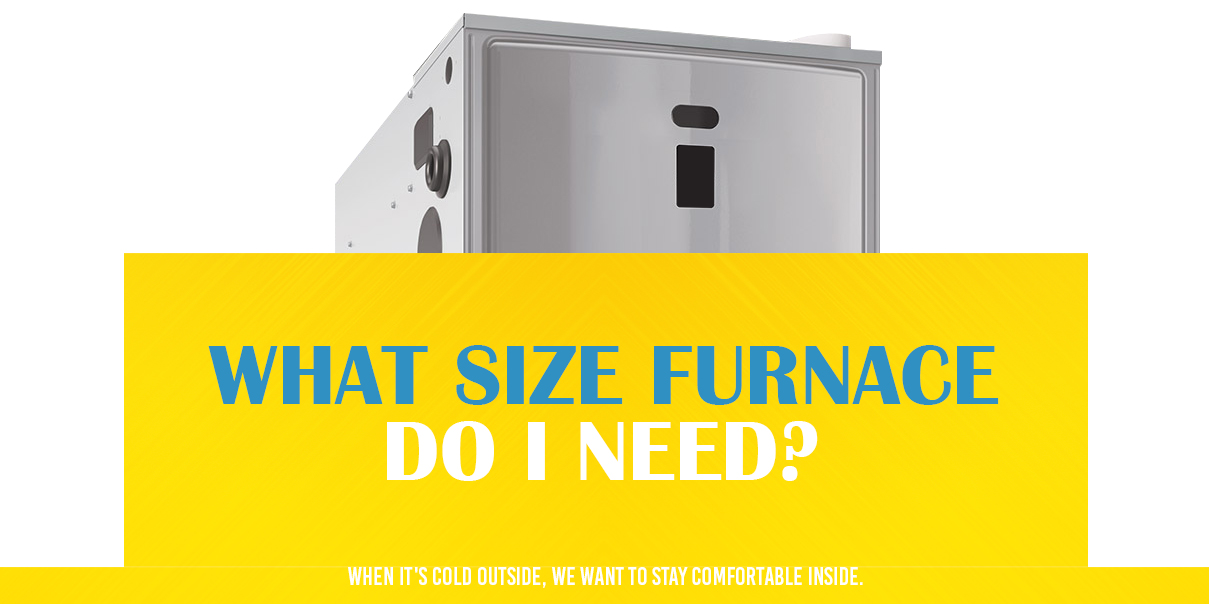
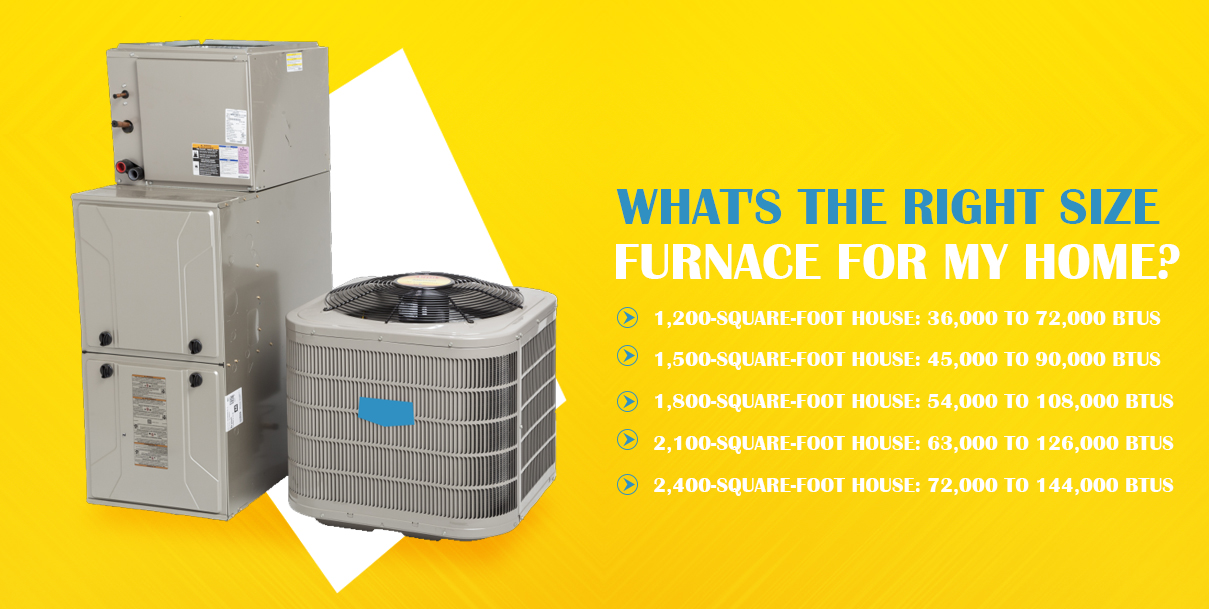
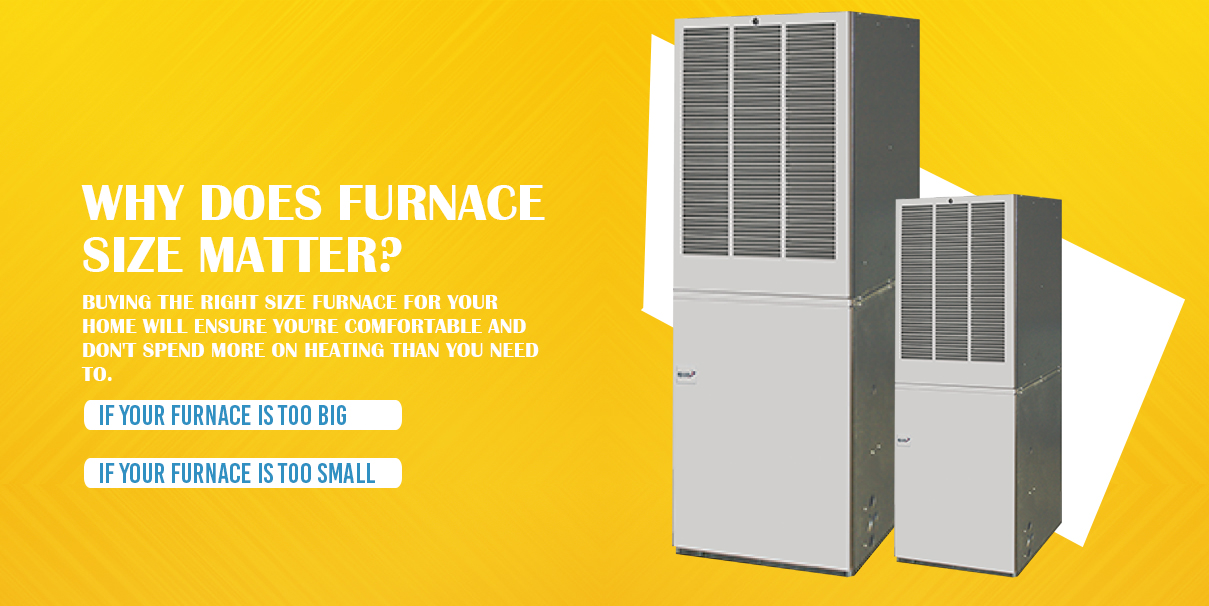
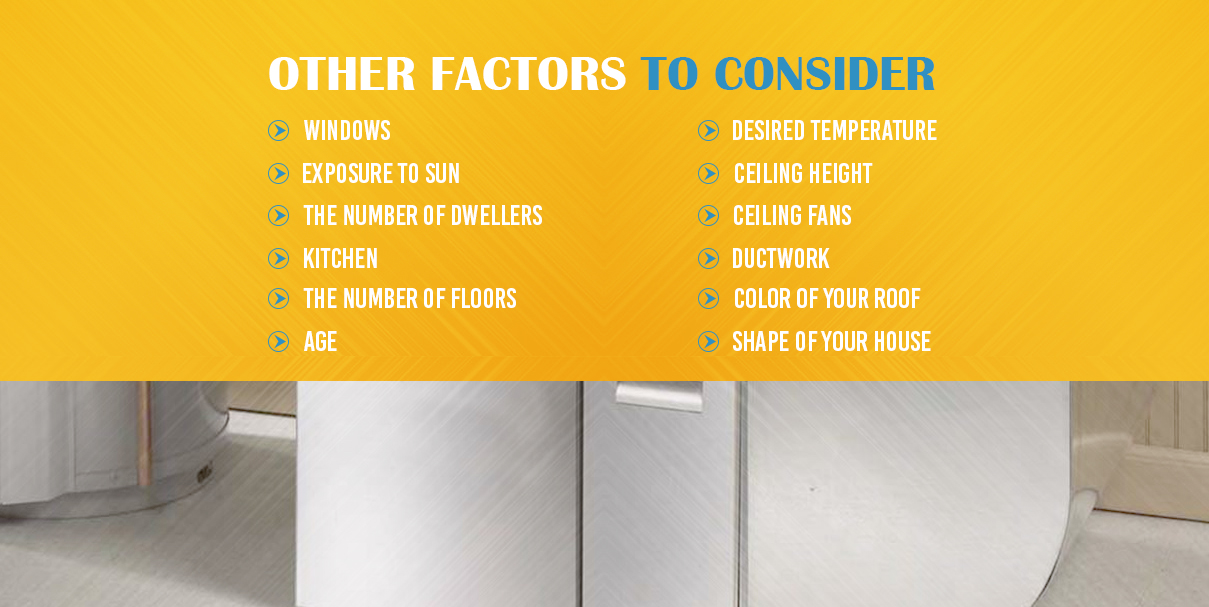
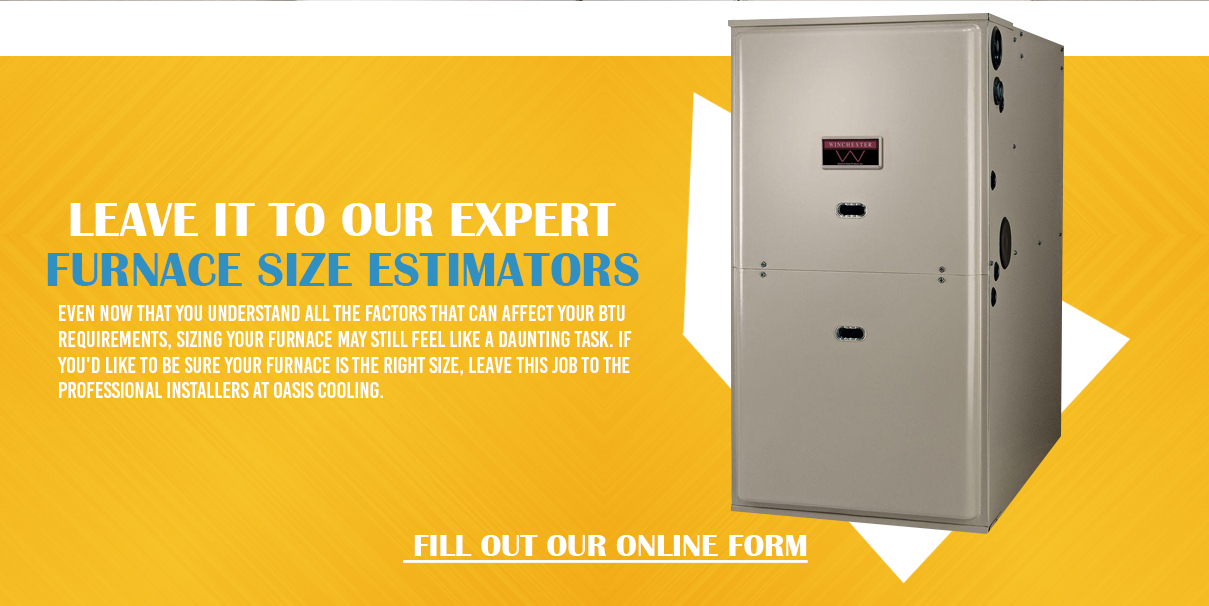
![([site_name)]](/assets/templates/main/images/footer-logo.png)



